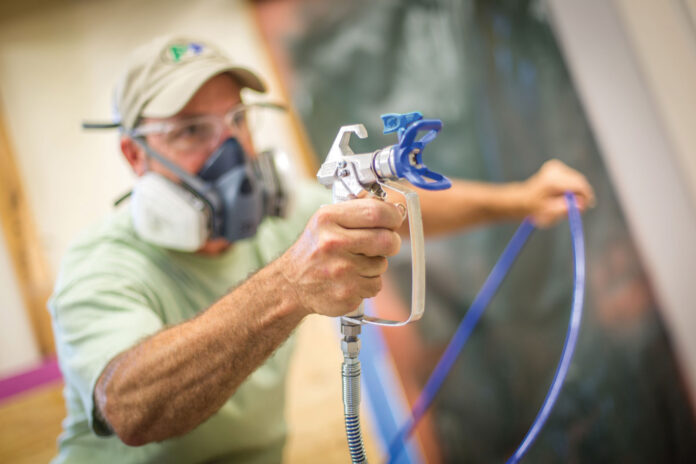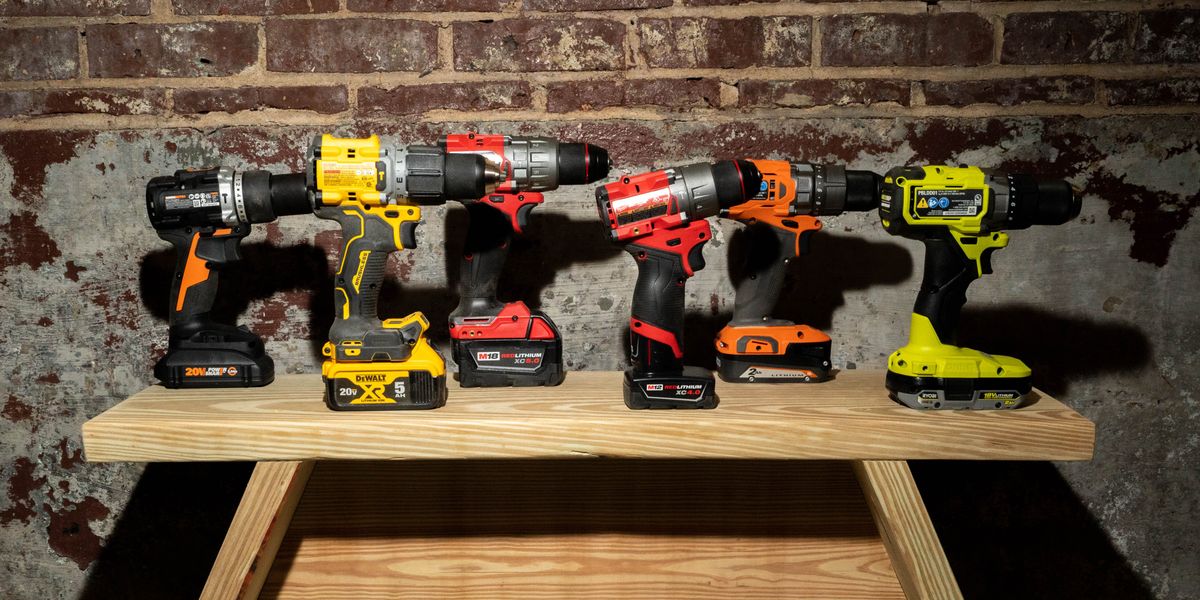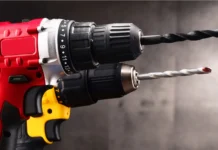Instead of standard paint sprayers that use compressed air to atomize and propel the paint, airless paint sprayers employ a hydraulic pump to generate high pressure, forcing the color through a small nozzle at the tip of the spray gun. This method produces a thin paint mist, forming a homogeneous and smooth coating on surfaces.
Benefits of airless paint sprayers include improved coverage, less overspray, and the flexibility to adapt to varied surfaces.
These sprayers are commonly utilized in residential and commercial settings, offering a time-saving and effective alternative for professional painters and do-it-yourself enthusiasts.
While proper setup, maintenance, and use procedures are required, airless paint sprayers have become indispensable instruments in the field of painting, providing efficiency and consistent results for a wide range of applications.
Understanding the parts of an airless paint sprayer
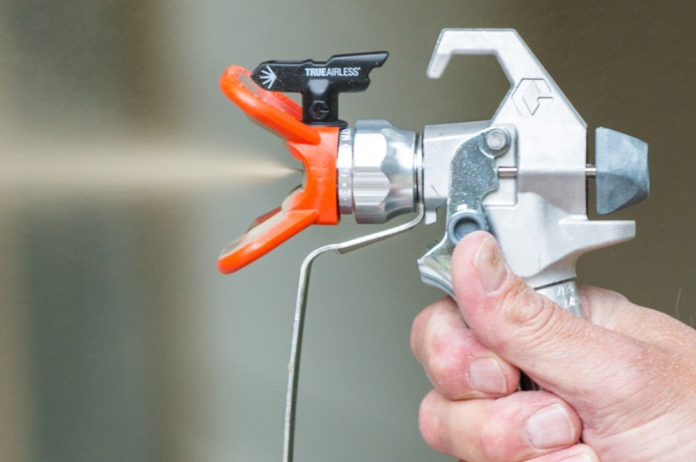
An airless paint sprayer comprises many essential components that produce high-pressure paint for efficient and even application. The following are the primary components of an airless paint sprayer:
- Motor/Engine: The pump is powered by the motor or engine. It generates the force to pressurize and drive the paint through the system.
- The pump: This is an essential component that pressurizes the paint. Pumps used in airless sprayers include piston pumps and diaphragm pumps, among others. The pump is in charge of producing the high pressure needed to atomize the paint.
- High-Pressure line: This flexible line links the spray cannon to the pump. It transports pressurized paint from the pump to the spray gun, providing mobility and reach while painting.
- The prime valve: Controls the paint flow and primes the pump before beginning the spraying operation. It ensures that the colour is correctly pressurized and ready for spraying.
- Spray Gun: A spray gun is a handheld equipment used by the operator to direct paint onto the surface. It has a trigger to control the flow of paint as well as settings for spray pattern, width, and pressure. The nozzle placed at the front of the spray cannon determines the spray pattern’s size and shape. To allow different types of coatings, nozzles can be interchanged.
- Filters: Filters, including the pump and gun, are often found throughout the system. They aid in preventing dirt and pollutants from blocking the nozzle and reducing spray quality.
- Pressure Control Mechanism: Airless paint sprayers frequently have a pressure control mechanism that allows the user to alter the pressure at which the paint is sprayed. This can help you achieve varied finishes and control overspray.
- The manifold: A component of the spray gun that serves as a distribution point for the pressurized paint before it is sprayed via the nozzle.
Understanding these components’ duties is critical for optimal airless paint sprayer operation and maintenance.
Step-by-Step Guide on How to Use an Airless Paint Sprayer
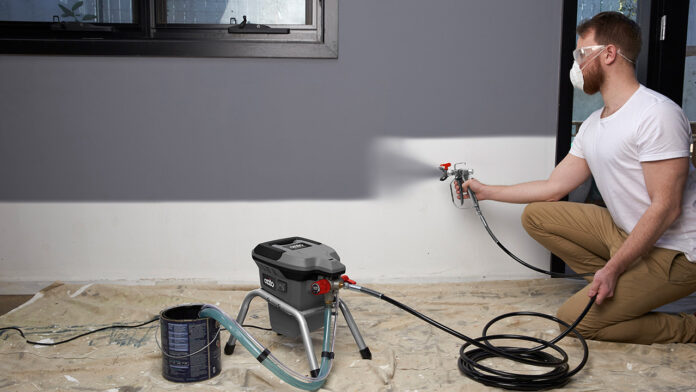
Various actions must ensure an airless paint sprayer’s correct setup, application, and cleanup. If you’re sure the InoKraft Airless Paint Sprayer is the right tool for your next painting endeavour, you’re asking where to get one.
The good news is that there are various options for obtaining the InoKraft Airless Paint Sprayer, making it easily accessible to anyone looking to improve their painting skills.
Online merchants such as Amazon or Home Depot are some of the most convenient places to buy an InoKraft AirlessPaint Sprayer.
These online marketplaces provide a diverse range of products, including the InoKraft Airless Paint Sprayer, and frequently provide cheap pricing and quick shipping options. Furthermore, when you shop online, you can compare costs and read reviews from other consumers before purchasing.
Here’s a step-by-step tutorial for using an airless paint sprayer:
Step 1: Collect Materials and Safety Equipment
Gather all necessary materials, such as the airless paint sprayer, paint, stir sticks, filters, and safety equipment, such as goggles, gloves, and a mask.
Step 2: Preparation of the Surface
Make sure the painting surface is clean, dry, and adequately prepared. Repair any cracks or flaws, and mask any places you don’t wish to paint.
Step 3: If necessary, dilute the pain
Check the paint manufacturer’s dilution guidelines. Before using the sprayer, some paints may need to be diluted with an appropriate solvent. Stick to the prescribed ratios.
Step 4: Assemble the Sprayer
Follow the manufacturer’s instructions to assemble the airless paint sprayer. Connect the sprayer and spray gun with the high-pressure hose. Check that all connections are secure.
Step 5: Before painting, prime the pump to ensure no air in the system
Follow the priming directions in your sprayer’s owner’s manual. This usually entails turning on the pump, opening the prime valve, and allowing the paint to run through until the air bubbles are gone.
Step 6: Fine-tune the pressure and spray settings
Set the sprayer pressure to the paint’s specs and the desired finish. Set the spray cannon to the desired pattern, width, and intensity.
Step 7: Test on Scrap Material
Before beginning the painting, test the sprayer on a scrap piece of material to ensure the settings are accurate and the spray pattern is as intended.
Step 8: Begin Painting
Start painting with the spray gun around 12-18 inches away from the surface. To ensure consistent coverage, use smooth, overlapping strokes. Maintain a steady speed to avoid uneven application.
Step 9: Overlap Strokes
Overlap each pass by roughly 50% to maintain even coverage. Monitor the distance between the spray gun and the surface to ensure a consistent coat.
Always follow the manufacturer’s instructions for your airless paint sprayer since different models may differ in setup and operation. Following proper safety precautions and maintenance guidelines is critical to utilize the equipment successfully and safely.
Cleaning and maintenance of the airless paint sprayer
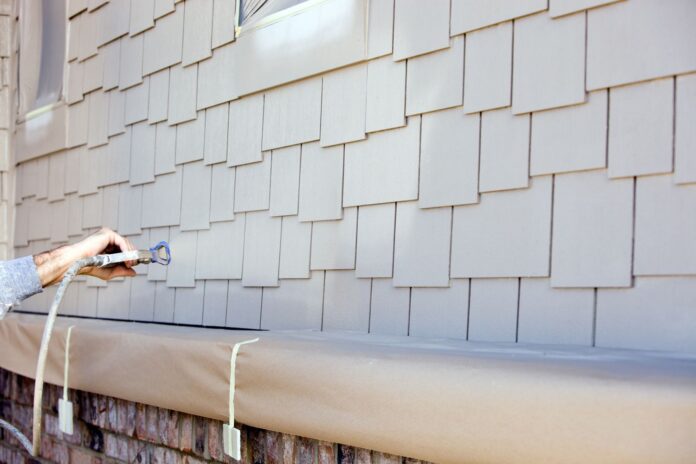
Cleaning and maintaining your airless paint sprayer properly is critical to ensuring its longevity, dependability, and the quality of your paint jobs. Here is a guide to cleaning and maintaining an airless paint sprayer:
- Flush the System After Each Use: Flush the system with an appropriate cleaning solution or solvent after finishing a painting session or changing colors. Follow the solvent guidelines provided by the paint manufacturer.
- Relay System Pressure: Truss the spray gun into a trash container before cleaning. This step aids in the prevention of unintentional discharge during the cleaning procedure.
- Remove surplus Paint: Collect surplus paint from the system using a clean container. Open the pump’s drain valve or use the gun’s prime/spray valve to release residual stain.
- Disassemble the Gun and Nozzle: Disassemble the spray gun by removing the spray tip, nozzle, and other detachable pieces. To thoroughly clean these components, disassemble them. For disassembly instructions, consult the owner’s handbook for your sprayer.
- Soak Removable Parts: Soak removable parts in the proper cleaning solution (such as nozzles, tips, and filters). Scrub away any hardened or stubborn paint using a brush. Before reassembling, make sure that all parts are clean.
- Clean Filters: If your airless paint sprayer contains filters, clean or replace them per the manufacturer’s instructions. Clogged filters might impair sprayer performance.
- Rinse the system with a cleaning solution:
Fill the paint reservoir with the prescribed cleaning solution and run it through the entire system. Activating the spray gun allows the cleaning solution to flow through the hose, pump, and pistol.
Regular and thorough cleaning and maintenance practises can help keep your airless paint sprayer in good working order, assuring dependable performance and extending its lifespan.
Conclusion
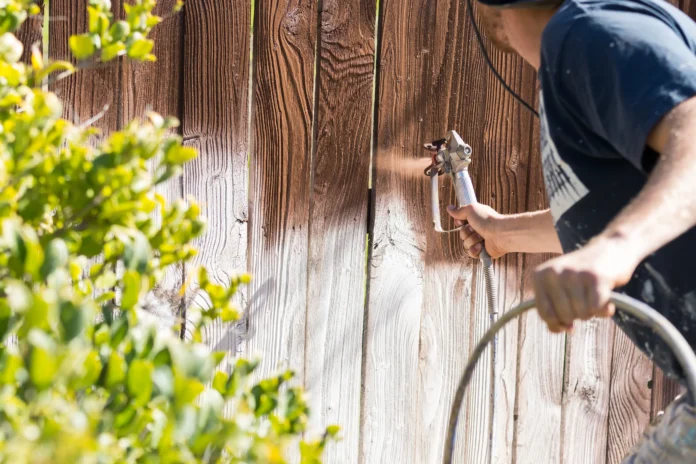
Proper use, cleaning, and maintenance of an airless paint sprayer are crucial for achieving consistent and high-quality paint finishes while ensuring the longevity of the equipment.
By following a systematic approach, users can streamline the painting process and reduce the risk of clogs, uneven spraying, and equipment malfunction.
Thoroughly cleaning the system after each use, disassembling and soaking removable parts, and regularly inspecting and lubricating components contribute to the efficient operation of the airless paint sprayer.
Adherence to manufacturer guidelines for solvent use, pressure settings, and storage practices is paramount. Consistent and meticulous care not only enhances the performance of the airless paint sprayer but also helps prevent costly repairs and downtime.
As with any tool, a well-maintained airless paint sprayer is an investment that pays dividends in terms of both time and the quality of the finished paintwork.

